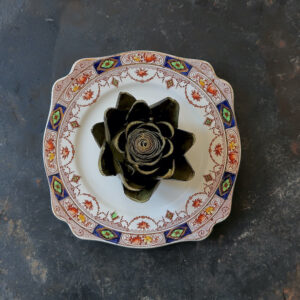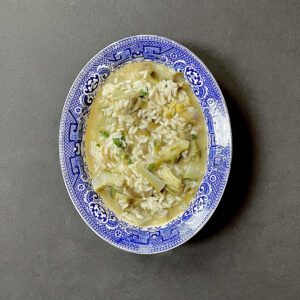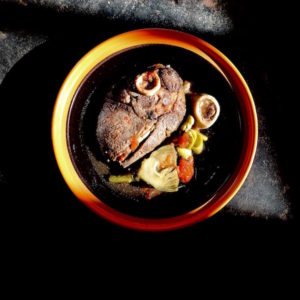Chicken with Baby Artichokes and Rice
People assume every meal around here is a multicourse wonder, each dish more stunningly photogenic than the next.
Nothing could be further from the truth.
In fact, over the past few days, as markets filled with spring produce, I couldn’t think of a damned thing to cook, much less blog.
A saner person would’ve ordered pizza.
Instead, I prepared my usual fallback meal: chicken with rice and a vegetable. In this case, the vegetable is baby artichoke.
There is nothing novel about this meal. It is plain, but plain isn’t necessarily a bad quality. It need not connote dullness. Cooked with care and attention, even the boneless, skinless chicken breasts used here can be moist and flavorful.
You’ll notice there are fava beans mixed in with the artichokes. But that would’ve meant four recipes, and four recipes in a single post is a bit much. Besides, I’ve discussed fava beans before. If you’re in need, here is a recipe.
Into the kitchen.
Working backward, we’ll start with the rice. I use Three Ladies Basmati. They are not comping me to mention them; I just like their rice.

Like many people, I am not a born rice cook. If you share my plight, my advice is to find a brand of rice you like and stick with it. While you’re at it, find a heavy, lidded pot and use it every time you cook rice. If you can find a Chinese sandpot, they make excellent rice cooking vessels.
If you own a rice cooker, obviously none of the above applies. Here are some virtual earplugs to drown me out.

On to the artichokes. Note the artichoke pictured, below.

It may not look pretty, but there’s nothing wrong with it. The black tipped leaves mean the artichoke survived frost. Trim the blackened tips off and you’ll find the vegetable beneath is perfectly edible.

A quick lesson in artichoke prep:
Break off the outer leaves until you reach the light green leaves, pictured above. Now, using either a serrated knife or a sharp chef’s knife, cut off the top quarter of the leaves, which are spiky and inedible.

Now, using a paring knife or vegetable peeler, trim any hard bits from the choke. If your artichokes have stems, pare off the hard outer exterior, revealing the softer inner stem. Don’t throw this bit away–it’s part of the heart, and it is delicious.
You can quarter the artichokes or leave them whole. Either way, toss them into a small saucepan of simmering water acidulated with lemon. (Or cheap white wine.) Don’t worry about the artichokes browning. The discoloration will vanish during cooking.

Finally, the chicken.
Admit you love chicken breasts, and watch people turn their noses up.
Chicken breasts get their bad rap from poor preparation. Like other lean proteins, the chicken breast requires attentive cooking. Given you are only required to attend for about eight minutes, this is not so much to ask.

Somebody out there may be able to shoot raw chicken fetchingly. Not me.
Some of you may be wondering why the chicken was cut up. After all, this isn’t a stir-fry. The answer is convenience: I live with a person who needs his food cut up. Sometimes it’s easier to do this before cooking. Obviously, mine is an unusual case. Feel free to leave your chicken pieces whole. If you are cooking for small people or disabled individuals, cutting the chicken before cooking saves a little time up front.

All my usual disclaimers concerning varying the seasonings, cooking methods, and vegetable accompaniments apply here. Meaning you can use whatever herbs and spices you like, cook the chicken in the oven, and accompany the chicken with whatever veg you like. For example, fava beans, which I said we were going to ignore. Well, here they are.
Chicken with baby artichokes and rice needs nothing else, but a green salad never hurts. Nor does a nice loaf of bread.

Leftovers, should you have any, make a nice sandwich.

Not a sandwich, but you knew that.
Chicken with Baby Artichokes and Rice
prep time: 45 minutes
Serves: 2-3
Please read notes before cooking.
For the rice:
1 cup/454 grams Basmati rice
2 cups/900 ml water
You will need a small, sturdy lidded pot. My rice pot holds 2 quarts/liters.
Pour the rice into the pot. Pour the water over. The water should cover the rice to the depth of the first joint of your index finger.
My rice pot is clay, so I have to heat it gradually. I turn the heat to medium low, and slowly bring it to medium high. Once the water reaches a gentle boil, I put the lid on and turn the heat down to a simmer.
Keep an eye on the pot, as the water can sometimes boil over, a tendency checked by turning the heat down and lifting the pot lid (briefly!).
Rice is done when all the water is absorbed and you can see “pits” in the rice. If unsure, taste a small amount. If rice is not done, add a small amount of water and continue cooking. If done, keep lid on until serving time.
For the artichokes:
1/2 pound/227 grams baby artichokes (see notes)
fresh lemon juice, bottled lemon juice, or white wine, to acidulate
water
salt
fresh lemon juice, to taste
salt and pepper, to taste
olive oil
Fill a small saucepan about a quarter full of water. Add about a teaspoon of salt. Add a squeeze of fresh lemon (it’s okay if seeds get in there), or a couple teaspoons of bottled lemon juice, or a glug of wine. Turn heat on low while you prep the artichokes.
Break off the outer leaves until you reach the light green leaves. Now, using either a serrated knife or a very sharp chef’s knife, cut off the top quarter of the leaves, which are spiky and inedible.
Now, using a paring knife or vegetable peeler, trim any hard bits from the choke. If your artichokes have stems, pare off any stringy bits, revealing the softer inner portion. Don’t throw this bit away–it’s part of the heart, and it is delicious.
You can quarter the artichokes or leave them whole. Either way, toss them into the saucepan.
Once all the artichokes are in the pot, bring the heat to a gentle boil and cook for about 20 minutes. Test for doneness with a fork or knife; either should slip through the artichoke easily. Total cooking time depends on the size of the vegetable; small ones shouldn’t take longer than 30 minutes.
Drain artichokes in a colander, or if you’re lazy like me, move artichokes directly to plates and pat dry with paper towel. Season with fresh lemon, salt, pepper, and a little olive oil.
Artichokes can discolor knives and pots. If this happens to your cookware, clean it by shaking a little baking soda (bicarb if you’re in the UK) on a sponge to make a paste. Rub it on the discolored area. It should clean up nicely.
For the chicken:
approximately 1 pound/454 grams boneless, skinless chicken breast
2.5 tablespoons olive oil
1/3 cup/80 ml white wine, Vermouth, light chicken broth, or water
a generous 2 tablespoons fresh lemon juice
1 teaspoon salt
1 teaspoon pepper
1 teaspoon sumac (optional)
1-2 garlic cloves, smashed and peeled (optional)
Bring the chicken to room temperature before cooking.
You will need a large saute pan. I used 10.5 inch/26 cm stainless steel pan to saute the chicken.
As discussed in the post, I sliced the chicken before cooking. You need not, but it will cook more quickly if you do. If not, you might give the thicker portions a few bashes with a meat mallet to ensure even cooking. Up to you.
Slice the chicken, or bash it. Or not. Wash your hands and the knife with hot soapy water. I’ll wait.
Place the frying pan on medium heat. Pour in the olive oil and white wine. Squeeze in lemon. If you’re me, try to fish seeds out. Do not burn yourself. Gordon Ramsay isn’t coming over to critique your cooking.
Toss in garlic.
Add the chicken. Don’t crowd the pan; better to cook in relays.
Season with salt, pepper, and sumac, if using.
Adjust heat to gentle burble. Cook about 4-5 minutes a side: you will see the chicken cook. Flip. Season second side.
Some bits may require more cooking than others; you may want to move the pan or pieces of chicken around. Total cooking time, for me, was 8 minutes. Don’t overcook, but don’t undercook, either. Life is hard enough without getting sick from undercooked chicken.
The rice, artichokes, and chicken may plated and placed in a low oven, covered, for about an hour.
Leftover rice may be refrigerated up to two days.
The chicken may be refrigerated up to four days and frozen up to three months.
The artichokes may be refrigerated up to four days. You could freeze them, but I don’t advise it, as they would suffer in flavor and texture.
Notes
If you are unable to find baby artichokes, use artichokes of any size or any other vegetables of your choice. Green beans, peas, fava beans, zucchini, summer squash, or whatever looks appealing is fine.
The chicken may be oven roasted at 325/160 for 45-60 minutes. Check for doneness at 45 minutes.
If you loathe chicken breasts, use another cut. Adjust cooking time accordingly.
Most rice cooking instructions tell you to wash rice before cooking. I live in drought country, so do not. If your rice is coated, dusty, or otherwise looks like it needs rinsing, do so before cooking.





